Dwarf seahorses are some of the most amazing little seahorses there are. Very tiny, only about an inch or so long, they are fascinating and adorable to watch. They do, however, have very specific care needs that differ from the larger seahorse species you see for sale most often in the local fish stores.
The Tank
Let's start by talking about their home. When you decide you 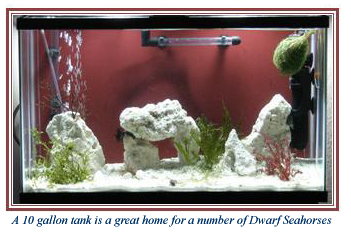 want to keep dwarf seahorses, the first question that comes to mind is usually, "what size tank do I need?" That answer can vary depending on your goals with this seahorse. If you want to keep only a few pairs, then a smaller tank is going to be just fine. However, dwarves will not do well in a fishbowl setting. They will require filtration and water movement, so a conventional tank is going to be the best choice. Most recommendations call for between 2 and 5 gallons, but a 10 gallon tank might be better. You have to keep in mind that dwarves are prolific and will produce dozens of broods of babies. You could quickly find your 2 or 5 gallon tank overrun with the parents and their fry. Generally we tend to steer people towards 10 gallon tanks. These provide plenty of room for your original group of seahorses and all the babies that they will very likely produce. Not to mention, it leaves you the option to add more horses at a later time without needing to redo your entire setup. want to keep dwarf seahorses, the first question that comes to mind is usually, "what size tank do I need?" That answer can vary depending on your goals with this seahorse. If you want to keep only a few pairs, then a smaller tank is going to be just fine. However, dwarves will not do well in a fishbowl setting. They will require filtration and water movement, so a conventional tank is going to be the best choice. Most recommendations call for between 2 and 5 gallons, but a 10 gallon tank might be better. You have to keep in mind that dwarves are prolific and will produce dozens of broods of babies. You could quickly find your 2 or 5 gallon tank overrun with the parents and their fry. Generally we tend to steer people towards 10 gallon tanks. These provide plenty of room for your original group of seahorses and all the babies that they will very likely produce. Not to mention, it leaves you the option to add more horses at a later time without needing to redo your entire setup.
Substrate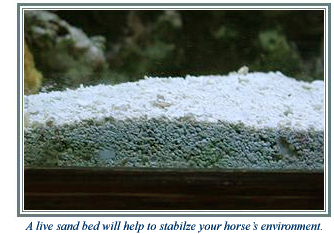
Substrate is the next component to consider for your dwarf seahorse home. You'll want to use sand. There are options in black or white, or whatever mixture appeals to you. Since dwarf seahorses tend to live in sea grass beds in the ocean, they are accustomed to fine sand. We suggest about an inch of sand in the bottom of the tank, a little more is fine. A deep sand bed is only going to decrease your water volume and is not really practical for this small of a tank. We have not noticed any drawbacks to live sand in a dwarf tank. It can have many benefits towards the cycling and stabilization of the tank,and for those reasons alone is highly recommended. Commercially available bags of live sand do not have the potential for carrying the dangerous hitchhikers that we see in live rock, so this type of live sand is considered safe. Be wary of live sand that is collected from other systems, or directly from the ocean. These types of live sand can be as problematic as live rock.
Filtration
Once the substrate is chosen, you'll need to consider filtration. This takes some care, as babies and even adult dwarves can get sucked into the intakes of many of modern filter systems. Depending on your choice, you may have to consider dividing your tank to keep the dwarves safe from the filtration devices you select. Small HOB filters and sponge filters are generally recommended. It's best to cover the intakes on most HOB filters with pantyhose or a fine-pored sponge to prevent any dwarves being sucked in or against the intakes.
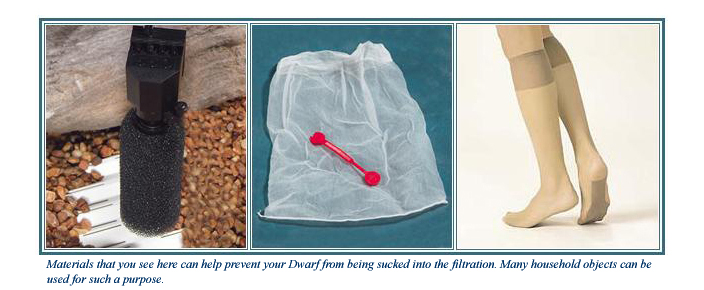
Decorations
The decor in the dwarf seahorse home is entirely a matter of personal taste, but 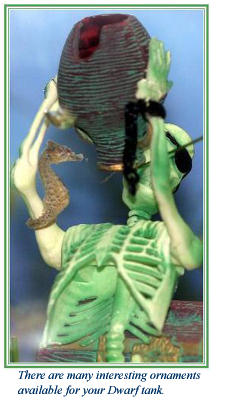 you'll definitely want to be careful in selection if you are going for a natural tank setup. Take care to use only hydroid free live rock. In fact, the author prefers to not use any live rock in a dwarf tank at all. You can obtain dead rock and let it become live in the tank, thereby insuring that there will be no dangerous predators brought in that could hurt your dwarves. If you do decide to use live rock, it is recommended that you treat it with Panacur before adding it to your tank. For specific dosing requirements please refer to this post. you'll definitely want to be careful in selection if you are going for a natural tank setup. Take care to use only hydroid free live rock. In fact, the author prefers to not use any live rock in a dwarf tank at all. You can obtain dead rock and let it become live in the tank, thereby insuring that there will be no dangerous predators brought in that could hurt your dwarves. If you do decide to use live rock, it is recommended that you treat it with Panacur before adding it to your tank. For specific dosing requirements please refer to this post.
Dwarf seahorses definitely enjoy lots of hitching posts since they tend to be sedentary creatures and spend a great deal of their time hitched, waiting for an opportune meal to come swimming by. Plants and things that are not too thick for their tiny tails to grab onto will be appreciated and used often. You can use plastic plants or live macro algae but if using live, again, be sure to take care that there are no hydroids or unwanted hitchhikers on them. A short fresh water dip (about 30 minutes) for live macro is tolerated. This is a good idea in any tank, but especially in dwarf tanks.
Cycling
Now that the tank is all planned out, it's time to get it set up and start it cycling. Do NOT, under any circumstances, place dwarves into an uncycled tank. It is absolutely critical to make sure that their new home is completely cycled and safe for them to move into. Cycling a tank is a fairly simple process but it does require time and above all else, patience. Do not believe any products that claim to instantly cycle a tank. One option is to cycle with a piece of shrimp or some frozen mysis dropped into the new tank and literally just let it decay. This will build up ammonia in the new tank, which is how the cycle will begin. There are other options, 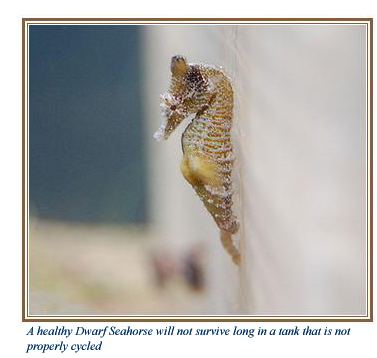 including one using pure household ammonia. The author doesn't use this method, but you can find more information about this method on the message boards of Seahorse.org. including one using pure household ammonia. The author doesn't use this method, but you can find more information about this method on the message boards of Seahorse.org.
During cycling you will want to test your tank every few days so that you can monitor the progress of the cycle. You should first see a spike in ammonia. Then you will start to see the ammonia reading decline and the nitrite reading increase. This signals that your tank is cycling properly, but it’s not ready yet! Next you will see a decrease in nitrites followed by an increase in nitrates. Eventually, in approximately 4 – 6 weeks, your tank will be at this stage. At this point it is recommended to “test” your beneficial bacteria and be sure the tank can handle the bio load you intend to add to it. This can be done by adding one day worth of food to the tank and monitor the ammonia and nitrite to be sure they stay at zero. Once the cycling process is complete you can safely add your dwarves to your new tank. It is still important that you follow proper quarantine procedures so that you do not introduce any of the nasty hitch hikers you’ve worked so hard to prevent already!
Purchasing Dwarf Seahorses
Now you are all cycled and ready to purchase the dwarves. There are a number of good vendors selling 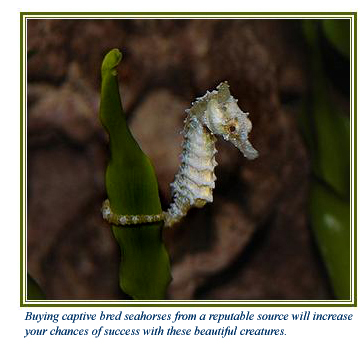 dwarves online, and even some selling captive bred dwarves. Captive bred is, of course, the better way to go, but they can often be cost prohibitive. Most new owners will choose to buy wild caught dwarves simply because of the substantially lower price. If you choose to go with wild caught dwarf seahorses, it will be necessary to take some precautionary measures when your new little friends arrive. Wild caught dwarves will often arrive with parasites and other nasties that you will not want to introduce into your tank. A freshwater dip is recommended to remove the worst of them. It is also highly recommended to quarantine the new horses in a hospital tank or specific quarantine tank for 6-8 weeks. During this time, you can watch them for any signs of disease or other problems and treat them accordingly. If you do notice problems with them, it’s a good idea to post on Seahorse.org so that we can help you to determine the best course of action for your specific problem. Once they have completed their quarantine, it will be time to move them into their new home. dwarves online, and even some selling captive bred dwarves. Captive bred is, of course, the better way to go, but they can often be cost prohibitive. Most new owners will choose to buy wild caught dwarves simply because of the substantially lower price. If you choose to go with wild caught dwarf seahorses, it will be necessary to take some precautionary measures when your new little friends arrive. Wild caught dwarves will often arrive with parasites and other nasties that you will not want to introduce into your tank. A freshwater dip is recommended to remove the worst of them. It is also highly recommended to quarantine the new horses in a hospital tank or specific quarantine tank for 6-8 weeks. During this time, you can watch them for any signs of disease or other problems and treat them accordingly. If you do notice problems with them, it’s a good idea to post on Seahorse.org so that we can help you to determine the best course of action for your specific problem. Once they have completed their quarantine, it will be time to move them into their new home.
Feeding
Dwarf seahorses will generally require daily feedings of live food. More often than not this is accomplished with newly hatched baby 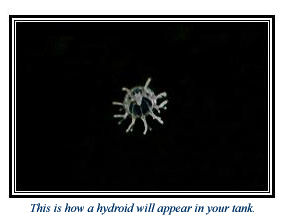 brine shrimp. The author also recommends feeding 2 day old brine shrimp enriched with various enrichments to keep them at their best health. Nutrition is a big concern with dwarves, and simply feeding them newly hatched BBS daily does not appear to be enough for them. That is why we recommend older enriched brine at least twice daily. Ideally, copepods would be the best food for them but the huge quantity of copepods required is very difficult for the average hobbyist to supply. Consequently, most hobbyists use live brine. Decapsulating and hatching brine shrimp cysts is not a very complicated process. With practice, this becomes a simple daily task. The decapping process is very important, as hydroids are known to survive on the shells of brine eggs and can suddenly appear in your dwarf tank. Hydroids are very dangerous to your dwarves and you will want to take any and all necessary measures to keep them out of your tank. Decapsulating your brine cysts will help to keep hydroids from infesting your system. Dwarf seahorses will appreciate being fed twice each day, three times if your schedule allows it. Feed them enough brine that the tank seems to be experiencing something like a moderate "snow shower". Try to avoid overfeeding. Adjust the amount of baby brine shrimp you put in at each feeding until you find the amount that they will finish in about 4 hours. If there is leftover brine at the next feeding always adjust accordingly. brine shrimp. The author also recommends feeding 2 day old brine shrimp enriched with various enrichments to keep them at their best health. Nutrition is a big concern with dwarves, and simply feeding them newly hatched BBS daily does not appear to be enough for them. That is why we recommend older enriched brine at least twice daily. Ideally, copepods would be the best food for them but the huge quantity of copepods required is very difficult for the average hobbyist to supply. Consequently, most hobbyists use live brine. Decapsulating and hatching brine shrimp cysts is not a very complicated process. With practice, this becomes a simple daily task. The decapping process is very important, as hydroids are known to survive on the shells of brine eggs and can suddenly appear in your dwarf tank. Hydroids are very dangerous to your dwarves and you will want to take any and all necessary measures to keep them out of your tank. Decapsulating your brine cysts will help to keep hydroids from infesting your system. Dwarf seahorses will appreciate being fed twice each day, three times if your schedule allows it. Feed them enough brine that the tank seems to be experiencing something like a moderate "snow shower". Try to avoid overfeeding. Adjust the amount of baby brine shrimp you put in at each feeding until you find the amount that they will finish in about 4 hours. If there is leftover brine at the next feeding always adjust accordingly.
Tank Maintenance
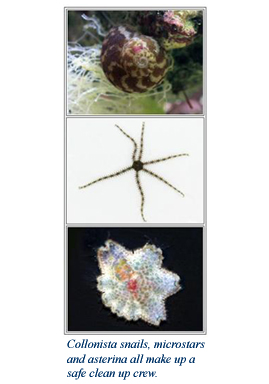 You will need to do regular maintenance on the dwarf tank. Weekly water changes of about about 10-25% are recommended. Clean up the substrate and wipe down the glass of the tank, if necessary. Check and maintain any filter cartridges you may have, replacing them regularly. After any general tank maintenance, it is a good idea to run water tests to be sure that all parameters are within range. You want the readings to be about 8.2 for pH, <10 Nitrates, 0 Nitrites and 0 Ammonia. We recommend the temperature for dwarves to be about 74 degrees or so. A little higher or lower is probably ok, but 74 seems to be comfortable for them. In a tank without invertebrates, keep dwarves at a specific gravity of about 1.019. With a clean and well maintained tank the dwarves should do very well. You may want to get some tankmates for your new dwarf seahorses, but there are very few that are acceptable and safe for them. Some snails will help to keep the tank clean and are generally safe. Most fish are inappropriate for dwarf seahorse tanks as they will either outcompete them for food, or will introduce pathogens that could harm them. Some fish might even harass your dwarves. Microstars are a great addition to a clean-up crew and are safe. There are a few corals that will survive in a dwarf tank, but generally most of them need different tank conditions than what is ideal for your dwarves. You will need to do regular maintenance on the dwarf tank. Weekly water changes of about about 10-25% are recommended. Clean up the substrate and wipe down the glass of the tank, if necessary. Check and maintain any filter cartridges you may have, replacing them regularly. After any general tank maintenance, it is a good idea to run water tests to be sure that all parameters are within range. You want the readings to be about 8.2 for pH, <10 Nitrates, 0 Nitrites and 0 Ammonia. We recommend the temperature for dwarves to be about 74 degrees or so. A little higher or lower is probably ok, but 74 seems to be comfortable for them. In a tank without invertebrates, keep dwarves at a specific gravity of about 1.019. With a clean and well maintained tank the dwarves should do very well. You may want to get some tankmates for your new dwarf seahorses, but there are very few that are acceptable and safe for them. Some snails will help to keep the tank clean and are generally safe. Most fish are inappropriate for dwarf seahorse tanks as they will either outcompete them for food, or will introduce pathogens that could harm them. Some fish might even harass your dwarves. Microstars are a great addition to a clean-up crew and are safe. There are a few corals that will survive in a dwarf tank, but generally most of them need different tank conditions than what is ideal for your dwarves.
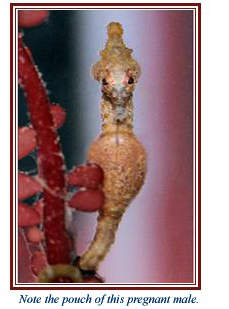 Courting and Fry Courting and Fry
If your dwarves are happy and healthy they will very likely begin to court and breed for you right away. The courting of dwarves is very interesting to watch. The males will quiver when they are close to a female they want to mate with, and the female will either respond by beginning a dance with the male or may ignore him completely. More often than not, the female responds, and 2 weeks later you’ve got baby dwarves! These babies can be raised right alongside their parents in the same tank, if you’d like. They can eat brine just like mom and dad right from birth. They often happily make themselves at home on dad’s snout (if dad will allow it), and they munch away at brine all day long. Dwarves grow fairly quickly and reach sexual maturity at age 3 months with proper nutrition. Their average lifespan is about a year or slightly more, and they will spawn repeatedly during this time.
Care for the dwarf seahorse is not hard, but it does take a little time, effort, and patience each day to make sure that your little herd is happy and well cared for. The dwarf seahorse is not a seahorse recommended for the new seahorse keeper. They have special needs, and will not readily train to frozen foods like many of the larger species do. They must have access to live foods daily. This can be a lot of work, and not a task to take on lightly. However, if you take on the challenge, and care for them well, they will provide you with hours and hours of pleasure with their daily activities. It is important to research thoroughly and ask lots of questions before you commit to getting into dwarf seahorses. If there are aspects of their care you feel would be too time consuming for your lifestyle, then please consider a different option. These tiny creatures rely on us for their care and it's our job not to let them down.
|
